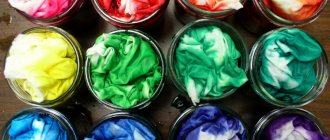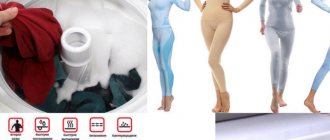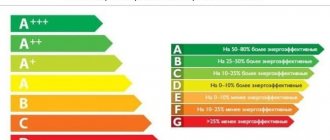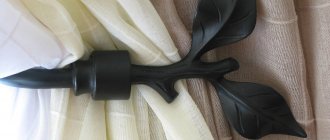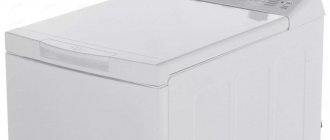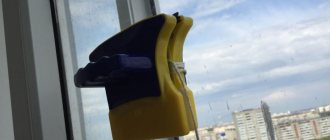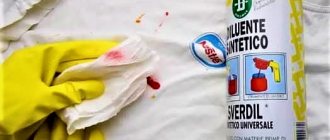Types of fabric paints
The most popular type of fabric paint is acrylic. These dyes do not penetrate into the fiber, but form a film on it. The painted area becomes dense and inelastic. Acrylic dyes are waterproof and have bright colors.
Aniline dyes penetrate into the fibers of the fabric, so the color lasts for a long time. Stamp inks are very durable and do not fade even after washing with bleach. They are used more for marking clothes than for dyeing.
Paints are produced in different forms:
- liquid in tubes or jars;
- spray in a can;
- powder.
You can purchase the dye at a hardware store or craft department. There is a whole network of hypermarkets for creativity “Leonardo”, where a large assortment of dyes is presented.
Hair dyes are not suitable for dyeing fabrics. They lie on the material unevenly, things turn out spotty. In addition, these dyes quickly fade and fade when washed.
It is also better to avoid painting fabric with green paint. The antiseptic gives a bright emerald color, but is easily washed off with water. When washed, it will fade and stain other things.
Chemical dyes
Acrylic dyes are based on polymers. Their advantages:
- There is always a wide range on sale;
- safe;
- the paint can be diluted with water;
- variety and brightness of colors;
- shades can be mixed to create new options;
- waterproof.
The disadvantages include the strong fluidity of the paint. Therefore, you need to make an additional outline on the fabric. During long-term storage, the dye thickens and loses its coloring properties.
Acrylic dyes can be used to dye any type of fabric:
- denim;
- silk;
- cotton;
- linen
The exception is wool, on which the dye will crack. On jars and tubes of paint there are marks:
- silk - for cambric, silk, chiffon;
- textile - leather, velvet, suede.
Acrylic fits well on dense material - the design gets clear boundaries and bright color.
Aniline dyes are also waterproof and come in liquid and powder. Suitable for dyeing natural fabrics - cotton, wool, linen. The pigment is water-soluble and liquid, making it inconvenient to paint with. Aniline dyes are suitable for changing the color of an entire item at once.
Stamp inks are:
- alcohol;
- water-glycerin;
- oil
They are applied to any type of fabric and are produced mainly in black or blue.
Natural dyes
Made from brightly colored plants. Less persistent than chemical dyes, but safe for allergy sufferers and people with chronic skin diseases.
Colors of natural dyes:
- yellow - turmeric root, orange zest;
- indigo - a mixture of spinach and turmeric;
- brown - onion peels, oak bark, tea leaves;
- gray - bearberry, broom;
- red or purple - beets;
- purple - blueberries;
- blue - sage.
They dye things by boiling them in a solution of natural dye. To fix the color, you need to hold the item in an alum solution for 20 minutes.
See how to paint with natural paints:
Aerosols
Aerosol paints are available in cans. They are convenient for painting large things - scarves, bedspreads. The pigment applies smoothly, without smears. The cans have different hole diameters, so you can paint large and small details of the design.
Glowing colors
Glowing dyes contain fine luminescent powder - phosphor. It glows in the dark. Does not contain phosphorus, therefore safe for humans. Fluorescent paints are made on the basis of plastisol. They glow in the dark or under UV light.
The reflective effect is achieved due to phosphor. Such pigments are used for application to children's clothing so that the child is clearly visible to motorists on a dark street.
Folk remedies
Natural paints include mint (for green), beets (for red and pink), activated carbon and other products containing a large amount of pigment.
Machine painting
But since in modern times there is a large selection of dyes for clothes, almost no one uses such recipes. In the past, many women would boil jeans or outerwear for several hours to give the item a fresh look.
You might be interested in everything you need to know about sewing men's suits and other clothing
Popular paint manufacturers
Manufacturers of acrylic paints:
- "Decola";
- "Delon";
- "Simplicol";
- "Marabou";
- "Pebeo";
- "Javana";
- "Gamma";
- "Pigment Acrylic";
- "Surf";
- "Ideal".
Lumier has gold and silver dyes that give a metallic effect.
St. Petersburg Decola paints are the most popular among batik artists. Sold individually and in sets. Additionally there are brushes, solvents, contours. The average cost is 110 rubles per 50 ml jar.
- French manufacturer. Their textile dyes are easy to use and safe. An additional assortment is represented by brushes, solvents, and stencils. The average cost is 300 rubles per 45 ml jar.
German offers a wide range of products. They have a lot of pigments of different colors, brushes, applicators, stencils. Pigments are convenient for drawing small details. To fix the color, just iron the item with an iron. The average cost is 70 rubles per 20 ml jar.
The pigments are suitable for coloring natural and synthetic materials. They are easy to use, even when painting by hand. Gives a rich color. The average cost is 70 rubles per 20 ml jar.
Screen printing inks are water-based. Light colored material should be dyed. The average cost is 130 rubles per 50 ml jar.
Stamp dyes
The main application is marking bed linen, towels, bathrobes in the hotel business, children's and medical institutions. Stamp inks can be used to apply small drawings and inscriptions on bags, blouses, scarves, and trousers.
Variety of chemical composition of pigments:
- Alcohol. Dries quickly and is resistant to boiling and heating.
- Water-glycerin. They are well absorbed and can withstand heating up to 70°. Be careful, the paint stains your hands!
- Oily. Long-lasting, slow-drying pigments.
- Invisible under normal lighting. Appears in ultraviolet light.
Dyeing fabric at home
Before you dye the fabric, you need to prepare it. The item, especially if it is new, should be washed. Many fabrics shrink after washing, so if you wash an item after dyeing, the design will become deformed.
For dark fabrics, you should use a primer - paint adheres better to it. The primer you need is not an ordinary acrylic one, it is too dense. White or pearlescent paints are suitable.
To work you will need the following tools:
- pencil or special solution for drawing an outline;
- tassels;
- cellophane film;
- hoops or frames for stretching fabric;
- a jar of water;
- stencils;
- cotton buds.
Useful tips for painting on fabric:
- you need to start painting with light acrylic paints, and then add dark tones;
- make color transitions quickly, because acrylic dries quickly;
- after applying the first layer, the item should be set aside to dry for a day;
- after painting is completed, dry the item for another day, and then iron it through the fabric;
- when dyeing, place cellophane under thin fabric so that the paint does not leak;
- To draw on the material, use a special marker, traces of which disappear after washing;
- During painting, brushes should be washed with clean water more often so that the colors do not mix.
After use, clean the brushes with a degreaser - nail polish remover, acetone.
See what mistakes you should not make when painting on fabric:
Variety of Applications
Fabric dyeing is in demand in textile manufacturing and in the fashion industry. Fashion stimulates the development of new clothing models and color solutions.
Dyes are widely used to add variety and revitalize interior items. The color and pattern of upholstery, curtains, and tablecloths can be changed to add zest, create coziness and comfort. Such an interior often becomes a source of special pride for the owners.
The purely utilitarian purpose of painting textiles is to give new life to faded and shabby items. It is in this case that the greatest difficulties should be expected. Uneven color and thickness of the fibers of the product results in the paint being absorbed unevenly. You need to know at least in general terms the characteristics of various pigments and fabrics in order to avoid a fiasco.
Material dyeing technology
You can paint things in different ways. Technologies for coloring the entire thing:
- manual - boil the item in a pigment solution;
- wash with pigment in the washing machine.
You don’t have to paint the entire material, but just apply a design to it. This technology is called batik.
In the washing machine
You can dye an item by washing it in a washing machine with dye. The method is simple and fast, but has a drawback - paint particles settle on the inner surface of the drum. Items may be damaged during subsequent washing.
After dyeing in the washing machine, you need to rinse it - run the washing cycle twice without clothes or with unnecessary fabric.
Algorithm for dyeing in a washing machine:
- dilute the paint and pour it into a container for powder;
- wet the item, put it in the drum;
- run the wash with water heated to 90 degrees for 30 minutes;
- turn off spin.
After washing, rinse the item with cold water.
To watch the video of coloring the product:
Textile preparation
Before you start dyeing fabric at home, you need to prepare it.
You need to know about some painting rules before starting work:
- White fabrics can be dyed almost any color. And before dyeing bright things and fabrics, first bleach and remove the pigment;
- It must be remembered that the effectiveness of dyeing depends on the composition of the fabric. Best of all, the dye adheres to cotton material;
- Before starting work, be sure to wash the items for uniform coloring;
- To understand how much paint is needed, things are weighed and this parameter is determined;
- Painting things should be done in distilled water. Soften regular running water with baking soda.
Synthetic material
How to preserve the pattern when painting things
Dye fastness is used to describe the ability of a color to resist fading or bleeding. The main forms of fastness are wash fastness, the ability to better retain patterns when dyed, light fastness, and abrasion resistance, as fabrics tend to fade with repeated washing, exposure to both ultraviolet and visible light, and friction.
The right fabric dye will ensure better color fastness. To ensure that a painted item retains its color, it must not be dried.
Working with clothing paint is not difficult. It is enough to choose a product for a specific fabric and purpose, read the instructions and do everything carefully.
walk in the sun. It's also always worth using a color fixative. When washing, it is better to use a gentle or special powder for colored items.
Azo dyes (cold dyeing).
Dyeing with azo dyes occurs by forming the dye directly on the fiber by combining its two components: the azo component (azotol) and the diazo component (amines) according to the following scheme:
diazo-component azo-component dye.
When dyeing with azo dyes, the fabric is pre-impregnated with an alkaline solution of the azo component at a temperature of 60-70°C. After drying, the nitrided fabric is passed through a cold (ice) solution of the diazo component. After spinning, the fabric goes through a maturing process, where the final combination of azo and diazo components occurs. After this, the fabric is washed and dried.
Preparatory work
The first step is to prepare the fabric to be dyed. It must be clean and free of stains darker than the paint it is being repainted with. If any are present, they need to be removed with a stain remover.
Important! If the stains cannot be removed, then you need to choose a shade of dye darker than the stains themselves. For example, black fabric dye.
You might be interested in this: Creating a pattern and sewing a wide belt for a dress
Before dyeing clothes you must:
- make sure there are no metal objects on it, such as buttons, zippers, etc.;
- it is necessary to remove starch from new items made of cotton and linen by washing them first;
- woolen products are rinsed in a solution of water with ammonia - add 2 tbsp per 12 liters. l. respectively;
- Skeins of yarn are tied in several places so that the threads do not get tangled.
At the next stage, prepare the container for painting. Take clean dishes, preferably enameled ones. Galvanized or aluminum vessels can be used, but all traces of scale must be removed from them before the process begins. The volume of the container must correspond to the size of the item being painted. It should be completely immersed in the composition and not wrinkle. Otherwise, there is a possibility of getting an unevenly colored item.
For painting you need to prepare a deep container and a wooden stick.
Wooden sticks are used to turn things over. Their surface should be smooth without knots so as not to damage clothing.
Use soft water. It is better if it is rain or melt water. If there is none, then the hardness can be reduced by adding 1 tbsp. l. soda per 12 liters of liquid.
